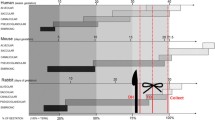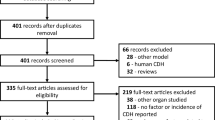Abstract
Purpose
Lineage tracing is key to study the fate of individual cells and their progeny especially in developmental biology. To conduct these studies, we aimed to establish a reproducible model of CDH in the most commonly used genetic background strain that is C57BL/6J mice.
Methods
CDH was induced in C57BL/6J dams by maternal administration of nitrofen + bisdiamine at E8.5. Fetuses from olive oil-gavaged mothers served as controls. Lungs from CDH and control fetuses were compared for (1) growth via radial airspace count (RAC), mean linear intercept (MLI) and gene expression for Fgf10, Nrp1, and Ctnnb1; (2) maturation (Pdpn, Spc, Ager, Abca3, Eln, Acta2, Pdgfra) via gene and protein expression; (3) vascularization via gene and protein expression (CD31, Vegfa, Vegfr1/2, Epas1, Enos). Statistics: unpaired t-test or Mann–Whitney test.
Results
Nitrofen + bisdiamine administration resulted in 36% left-sided CDH (31% mortality). CDH fetuses had hypoplastic lungs and impaired growth (lower RAC, higher MLI, lower Fgf10, Nrp1, Ctnnb1), maturation (decreased Pdpn, Ager, Eln gene expression), and vascularization (decreased Cd31, Vegfr1/2; Epas1 and Enos). Lower protein expression was confirmed for PDPN, ELN and CD31.
Conclusion
Modeling CDH in C57BL/6J mouse fetuses is effective in reproducing the classical CDH hallmarks. This model will be critical for lineage tracing experiments.



Similar content being viewed by others
Data availability
All data supporting the findings of this study are available within the paper.
References
Paoletti M, Raffler G, Gaffi MS, Antounians L, Lauriti G, Zani A (2020) Prevalence and risk factors for congenital diaphragmatic hernia: a global view. J Pediatr Surg 55(11):2297–2307. https://doi.org/10.1016/j.jpedsurg.2020.06.022
Russo F, Benachi A, Gratacos E et al (2022) Antenatal management of congenital diaphragmatic hernia: what’s next ? Prenat Diagn 42(3):291–300. https://doi.org/10.1002/pd.6120
Zani A, Chung WK, Deprest J et al (2022) Congenital diaphragmatic hernia. Nat Rev Dis Prim 8(1):37. https://doi.org/10.1038/s41572-022-00362-w. (Published 2022 Jun 1)
Antounians L, Figueira RL, Sbragia L, Zani A (2019) Congenital diaphragmatic hernia: state of the art in translating experimental research to the bedside. Eur J Pediatr Surg 29(4):317–327. https://doi.org/10.1055/s-0039-1693993
Clugston RD, Zhang W, Alvarez S, de Lera AR, Greer JJ (2010) Understanding abnormal retinoid signaling as a causative mechanism in congenital diaphragmatic hernia. Am J Respir Cell Mol Biol 42(3):276–285. https://doi.org/10.1165/rcmb.2009-0076OC
Clugston RD, Klattig J, Englert C et al (2006) Teratogen-induced, dietary and genetic models of congenital diaphragmatic hernia share a common mechanism of pathogenesis. Am J Pathol 169(5):1541–1549. https://doi.org/10.2353/ajpath.2006.060445
Rocke AW, Clarke TG, Dalmer TRA, McCluskey SA, Rivas JFG, Clugston RD (2022) Low maternal vitamin A intake increases the incidence of teratogen induced congenital diaphragmatic hernia in mice. Pediatr Res 91(1):83–91. https://doi.org/10.1038/s41390-021-01409-6
Kunisaki SM, Jiang G, Biancotti JC et al (2021) Human induced pluripotent stem cell-derived lung organoids in an ex vivo model of the congenital diaphragmatic hernia fetal lung. Stem Cells Transl Med 10(1):98–114. https://doi.org/10.1002/sctm.20-0199
Fox ZD, Jiang G, Ho KKY, Walker KA, Liu AP, Kunisaki SM (2018) Fetal lung transcriptome patterns in an ex vivo compression model of diaphragmatic hernia. J Surg Res 231:411–420. https://doi.org/10.1016/j.jss.2018.06.064
Kluth D, Kangah R, Reich P, Tenbrinck R, Tibboel D, Lambrecht W (1990) Nitrofen-induced diaphragmatic hernias in rats: an animal model. J Pediatr Surg 25(8):850–854. https://doi.org/10.1016/0022-3468(90)90190-k
Doktor F, Antounians L, Lacher M, Zani A (2022) Congenital lung malformations: dysregulated lung developmental processes and altered signaling pathways. Semin Pediatr Surg 31(6):151228. https://doi.org/10.1016/j.sempedsurg.2022.151228
Beurskens N, Klaassens M, Rottier R, de Klein A, Tibboel D (2007) Linking animal models to human congenital diaphragmatic hernia. Birth Defects Res A Clin Mol Teratol 79(8):565–572. https://doi.org/10.1002/bdra.20370
Burgos CM, Davey MG, Riley JS, Jia H, Flake AW, Peranteau WH (2018) Lung function and pulmonary artery blood flow following prenatal maternal retinoic acid and imatinib in the nitrofen model of congenital diaphragmatic hernia. J Pediatr Surg 53(9):1681–1687. https://doi.org/10.1016/j.jpedsurg.2017.12.002
Montedonico S, Sugimoto K, Felle P, Bannigan J, Puri P (2008) Prenatal treatment with retinoic acid promotes pulmonary alveologenesis in the nitrofen model of congenital diaphragmatic hernia. J Pediatr Surg 43(3):500–507. https://doi.org/10.1016/j.jpedsurg.2007.10.030
Montalva L, Zani A (2019) Assessment of the nitrofen model of congenital diaphragmatic hernia and of the dysregulated factors involved in pulmonary hypoplasia. Pediatr Surg Int 35(1):41–61. https://doi.org/10.1007/s00383-018-4375-5
Montalva L, Antounians L, Zani A (2019) Pulmonary hypertension secondary to congenital diaphragmatic hernia: factors and pathways involved in pulmonary vascular remodeling. Pediatr Res 85(6):754–768. https://doi.org/10.1038/s41390-019-0345-4
Wu SS, Lee JH, Koo BK (2019) Lineage tracing: computational reconstruction goes beyond the limit of imaging. Mol Cells 42(2):104–112. https://doi.org/10.14348/molcells.2019.0006
Kretzschmar K, Watt FM (2012) Lineage tracing. Cell 148(1–2):33–45. https://doi.org/10.1016/j.cell.2012.01.002
Kawamata M, Ochiya T (2011) Gene-manipulated embryonic stem cells for rat transgenesis. Cell Mol Life Sci 68(11):1911–1915. https://doi.org/10.1007/s00018-011-0669-7
Pradhan BS, Majumdar SS (2016) An efficient method for generation of transgenic rats avoiding embryo manipulation. Mol Ther Nucleic Acids. 5(3):e293. https://doi.org/10.1038/mtna.2016.9. (Published 2016 Mar 8)
Friedmacher F, Rolle U, Puri P (2022) Genetically modified mouse models of congenital diaphragmatic hernia: opportunities and limitations for studying altered lung development. Front Pediatr 10:867307. https://doi.org/10.3389/fped.2022.867307. (Published 2022 May 13)
Donahoe PK, Longoni M, High FA (2016) Polygenic causes of congenital diaphragmatic hernia produce common lung pathologies. Am J Pathol 186(10):2532–2543. https://doi.org/10.1016/j.ajpath.2016.07.006
Hsia CC, Hyde DM, Ochs M, Weibel ER, ATS/ERS Joint Task Force on Quantitative Assessment of Lung Structure (2010) An official research policy statement of the American Thoracic Society/European Respiratory Society: standards for quantitative assessment of lung structure. Am J Respir Crit Care Med 181(4):394–418. https://doi.org/10.1164/rccm.200809-1522ST
Crowley G, Kwon S, Caraher EJ et al (2019) Quantitative lung morphology: semi-automated measurement of mean linear intercept. BMC Pulm Med 19(1):206. https://doi.org/10.1186/s12890-019-0915-6. (Published 2019 Nov 9)
Bustin SA, Benes V, Garson JA et al (2009) The MIQE guidelines: minimum information for publication of quantitative real-time PCR experiments. Clin Chem 55(4):611–622. https://doi.org/10.1373/clinchem.2008.112797
Khalaj K, Figueira RL, Antounians L et al (2022) Treatment with amniotic fluid stem cell extracellular vesicles promotes fetal lung branching and cell differentiation at canalicular and saccular stages in experimental pulmonary hypoplasia secondary to congenital diaphragmatic hernia. Stem Cells Transl Med 11(10):1089–1102. https://doi.org/10.1093/stcltm/szac063
Kool HM, Bürgisser PE, Edel GG et al (2019) Inhibition of retinoic acid signaling induces aberrant pericyte coverage and differentiation resulting in vascular defects in congenital diaphragmatic hernia. Am J Physiol Lung Cell Mol Physiol 317(3):L317–L331. https://doi.org/10.1152/ajplung.00104.2018
Noble BR, Babiuk RP, Clugston RD et al (2007) Mechanisms of action of the congenital diaphragmatic hernia-inducing teratogen nitrofen. Am J Physiol Lung Cell Mol Physiol 293(4):L1079–L1087. https://doi.org/10.1152/ajplung.00286.2007
Grzenda A, Shannon J, Fisher J, Arkovitz MS (2013) Timing and expression of the angiopoietin-1-Tie-2 pathway in murine lung development and congenital diaphragmatic hernia. Dis Model Mech 6(1):106–114. https://doi.org/10.1242/dmm.008821
Nguyen TM, Jimenez J, Rendin LE et al (2019) The proportion of alveolar type 1 cells decreases in murine hypoplastic congenital diaphragmatic hernia lungs [published correction appears in PLoS One. 2019 Jul 3;14(7):e0217322]. PLoS ONE 14(4):e0214793. https://doi.org/10.1371/journal.pone.0214793
Shue E, Wu J, Schecter S, Miniati D (2013) Aberrant pulmonary lymphatic development in the nitrofen mouse model of congenital diaphragmatic hernia. J Pediatr Surg 48(6):1198–1204. https://doi.org/10.1016/j.jpedsurg.2013.03.013
Simon MM, Greenaway S, White JK et al (2013) A comparative phenotypic and genomic analysis of C57BL/6J and C57BL/6N mouse strains. Genome Biol 14(7):R82. https://doi.org/10.1186/gb-2013-14-7-r82. (Published 2013 Jul 31)
Hislop A, Reid L (1976) Persistent hypoplasia of the lung after repair of congenital diaphragmatic hernia. Thorax 31(4):450–455. https://doi.org/10.1136/thx.31.4.450
Acknowledgements
This project was supported by the Canadian Institutes of Health Research (CIHR) Project Grant (175300), SickKids Congenital Diaphragmatic Hernia Fund (R00DH00000) at the Hospital for Sick Children, Toronto, Canada and the Deutsche Forschungsgemeinschaft (DFG, German Research Foundation)—466815475.
Author information
Authors and Affiliations
Contributions
Conceptualization: FD, LA, AZ. Methodology: FD, RLF, KK, AI, MB. Visualization: FD, RLF, KK, AI, MB. Project administration: LA, AZ. Funding acquisition: FD, ML, AZ. Supervision: LA, ML, AZ. Writing—original draft preparation: FD. Writing—review and editing: LA, AZ.
Corresponding author
Ethics declarations
Cnflict of interest
The authors declare no competing interests.
Additional information
Publisher's Note
Springer Nature remains neutral with regard to jurisdictional claims in published maps and institutional affiliations.
Rights and permissions
Springer Nature or its licensor (e.g. a society or other partner) holds exclusive rights to this article under a publishing agreement with the author(s) or other rightsholder(s); author self-archiving of the accepted manuscript version of this article is solely governed by the terms of such publishing agreement and applicable law.
About this article
Cite this article
Doktor, F., Figueira, R.L., Khalaj, K. et al. Characterization of the congenital diaphragmatic hernia model in C57BL/6J fetal mice: a step toward lineage tracing experiments. Pediatr Surg Int 39, 296 (2023). https://doi.org/10.1007/s00383-023-05583-y
Accepted:
Published:
DOI: https://doi.org/10.1007/s00383-023-05583-y




